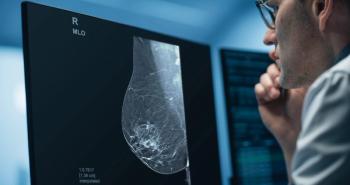
Full-field breast tomosynthesis makes return engagement
Hologic, which in recent years has made women’s health its principal focus, is showing its full-field digital breast tomosynthesis system as a work-in-progress for the second consecutive RSNA meeting. Despite growing interest in this technology, the company expects to present it as a work-in-progress again next year.
Hologic, which in recent years has made women's health its principal focus, is showing its full-field digital breast tomosynthesis system as a work-in-progress for the second consecutive RSNA meeting. Despite growing interest in this technology, the company expects to present it as a work-in-progress again next year.
"Our guess for commercialization is 2006," said Jack Cumming, chairman and CEO. "We think it has significant potential to redefine digital mammography, and I'm sure our competitors would echo that since they're also working on it."
Last year, Hologic became the first company to bring a full-field digital breast tomosynthesis system to the RSNA meeting. It returns with added clinical experience and a bona fide leadership position in tomosynthesis.
"We want to clearly demonstrate to the clinical community that we're very serious, very dedicated, and that we have made substantial progress," Cumming said. "This year we're showing a slightly different system. We've made some changes and are continuing to make them."
With tomosynthesis, a series of images are acquired and reconstructed for 3D viewing. This technology has the potential to eliminate overlapping tissue that can obscure lesions, and it may provide more complete diagnostic information.
Hologic is also showing its SecureView breast imaging workstation, which was cleared by the FDA in August. SecureView is a dedicated, multimodality workstation for displaying and interpreting screening and diagnostic digital mammograms. It can also accommodate MRI, CT, PET and ultrasound images.
Newsletter
Stay at the forefront of radiology with the Diagnostic Imaging newsletter, delivering the latest news, clinical insights, and imaging advancements for today’s radiologists.




























